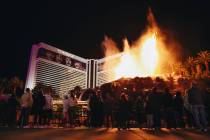Gaming’s spread no threat to Strip
Las Vegas has always suffered from an inferiority complex.
When Atlantic City’s first legal casino opened in 1978, naysayers thought it was Las Vegas’ death knell.
Obviously, that wasn’t the case.
Other “sky is falling” prognostications concerning the growth of riverboat casinos, regional markets, California’s tribal gaming expansion, and Macau came to the same end.
It now appears New York Gov. Andrew Cuomo wants to plop the world’s largest convention center in Queens, and it would include New York City’s only full-scale hotel-casino resort.
Malaysian gaming giant Genting wants to attach the convention facility to its plans for expanding Resorts World New York, the video lottery terminal casino at the Aqueduct Race Track. The $4 billion development includes three hotels with 3,000 rooms, an entertainment center and a casino that includes both slot machinelike VLTs and table games.
Should Las Vegas worry?
Fuhgetaboutit.
New York may be the city that never sleeps, but one resort — despite it’s anticipated size and scope — isn’t the Strip.
New York City has an estimated 86,230 hotel rooms spread throughout several boroughs. Las Vegas has almost 151,000 rooms, most of which are concentrated along the Strip’s roughly five-mile corridor that also covers three convention facilities, each with more than 1 million square feet of meeting space.
New York as a whole, however, is percolating with casino activity.
The state has nine commercial racetrack casinos, including Resorts World New York. There are also a handful of Indian casinos, mostly in the state’s northern region. Several tribes are looking at expansion opportunities, particularly in the Catskills. The Shinnecock tribe has shown interest in building a casino on Long Island.
A casino the size of a Strip resort in the heart of New York City, however, does seem a bit daunting.
Resorts World opened at the end of October and in less than three months, collected gaming revenues of $89.9 million. The casino helped boost the state’s VLT gaming revenue 68.3 percent in December.
Resorts World opened with 2,486 VLTs, including 220 electronic table games. The total number of machines grew to 5,000 in mid-December.
Wells Fargo Securities gaming analyst Dennis Farrell Jr. said Resorts World could take 5 percent to 10 percent of gaming revenue away from Atlantic City and Connecticut casinos.
“Chatter around gaming expansion has intensified, as the governor has proposed allowing additional casinos in the state, as well as the legalization of live table games,” Farrell told investors recently.
But it would take some doing for gaming expansion to take place.
Two consecutive state legislative sessions must pass a measure adding casinos or allowing VLT-only casinos to add table games. New York residents would then vote on the matter. Expansion is considered a constitutional amendment.
Then, there’s the matter of a casino at the Meadowlands Race Track across the river in New Jersey.
Deutsche Bank gaming analyst Andrew Zarnett speculates that fallout from the state’s gaming regulatory reforms last year could lead to a casino at the Meadowlands and two smaller casinos in Atlantic City.
New Jersey Gov. Chris Christie is reluctant to approve gaming outside Atlantic City, but Zarnett surmised that tax revenues generated by VLTs at the Meadowlands might be too lucrative to pass up.
“The emergence of gaming across new jurisdictions in the Atlantic Coast market, namely Massachusetts, New York and New Hampshire, may prompt lawmakers to soften their stance on legalizing a casino at the Meadowlands within two years,” Zarnett said.
Meanwhile, the potential for three resort casinos located in Miami — sometimes called the New York City’s “Sixth Borough” because of retirees and tourist traffic from the Empire State — is causing anxiety among several gaming observers.
So what could all this expansion mean to Las Vegas?
New jurisdictions might have created marginal negative impact on Las Vegas at their outset during the heavy expansion period from the mid-1990s to the mid-2000s, but the Strip continues to thrive, reaching a high point of almost $6.7 billion in gaming revenues in 2007.
The recession hit late in the last decade, and gaming revenues fell in successive years. However, recovery has seemingly taken hold. Strip revenues are up 5.2 percent through November.
Fuhgetaboutit.
Howard Stutz’s Inside Gaming column appears Sundays. He can be reached at hstutz@reviewjournal.com or 702-477-3871. He blogs at lvrj.com/blogs/stutz. Follow @howardstutz on Twitter.












